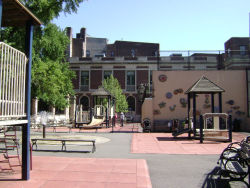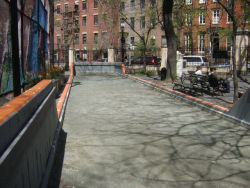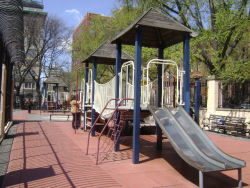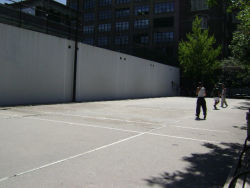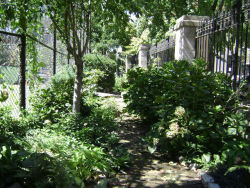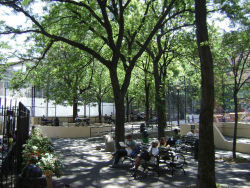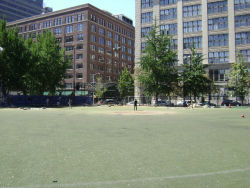James J Walker Park
The Daily Plant : Thursday, August 25, 2005
PRE-OWNED LAND
Even Bowling Green had a previous owner when it became the City’s first park in 1686. Likewise, each of our subsequent 1,800 properties had a previous owner and a previous use. Battery Park in Manhattan was once the location of a defensive battery of cannons. Farm Park in Queens was once—you guessed it—a farm. And until 1939, folks from the Bronx could go down to what is now called Ferry Point Park to catch a boat to Manhattan. You might say the previous roles of these sites are dead giveaways; however, the history of many of our parks lies further beneath the surface—often six feet under.
Even New York’s newer citizens know about the African burial ground that has been preserved just a little north of City Hall in Downtown Manhattan, and most know that Washington Square Park was once a cemetery; the clever ones even tell tall tales about the "hangmen’s elm." What few people realize is that New York City, especially Manhattan, was once riddled with cemeteries in what were originally far-off locations, distant from the downtown city core, but which were quickly overrun by development. Many of these burial grounds were potters fields, meaning people who did not have enough money to afford a private burial were interred there.
Originally, the City chose to make these potters fields "out of town," but New York expanded so quickly that the town ended up engulfing all the land in Manhattan aside from these old cemeteries. When these burgeoning neighborhoods sought open spaces for recreation, all they had left were the old burial grounds. Since there were no headstones on these paupers’ fields, nineteenth-century New Yorkers turned their heads and turned burial grounds into parade grounds. They were (in north-south order) James J. Walker Park, Washington Square, Union Square, Madison Sqaure, and Bryant Park.
In order to avoid the need for any future ghoulish land conversions, in 1847 New York State enacted the Rural Cemetery Act to encourage the building of cemeteries in unpopulated areas adjacent to urban areas (i.e., the Bronx, Brooklyn, and Queens). It was this act that closed the door to Manhattan burials and spurred a citywide interest in large, green, landscaped land preserves. Ironically, the creation of expansive, landscaped cemeteries in places like Brooklyn and Queens led the people in Manhattan to want green space of their own and thus began the movement to make Central Park.
Just about the same thing that happened in Manhattan in the 1820s through 1840s happened in the outer boroughs at the turn of the twentieth century. Apparently, the city fathers of Queens and Staten Island didn’t study their Manhattan history. Once again, when neighborhoods became crowded and the people needed parks, there was no place to turn but the cemeteries, and not just potters’ fields.
As early as 1730, the site of Newtown Playground in Queens at 92nd Street and 56th Avenue was used as a cemetery. Some of Newtown’s most prominent residents were buried there, and later it was used as a potters field on and off until about 1880. Although many of the famous and well-to-do were disinterred and buried elsewhere, this public space was transferred to the Queens Department of Parks in 1917. The 1927-28 Queens Parks Annual Report notes that "All the old headstones [one historian estimated as many as 86], which stuck up like eyesores, were laid flat and covered with soil." At that time, a "playground apparatus" and drinking fountain were installed, though it is not clear whether these were placed on or adjacent to the former cemetery site. The property was more fully developed as a playground in 1934-35, the dawn of the Moses era.
All told, there are more than 20 cemeteries within land that is now parks. Some of them, like Friends Cemetery in Prospect Park, remain untouched to this day; others are adjacent to our historic houses for all to see; but, in many cases, the clues of the past lie deep underfoot.
-written by John Mattera
QUOTATION FOR THE DAY
"The man who has no imagination has no wings."
Muhammad Ali
(born 1942)
Check out your park's Vital Signs
Clean & Safe
Green & Resilient
Empowered & Engaged Users
Share your feedback or learn more about how this park is part of a
Vital Park System

